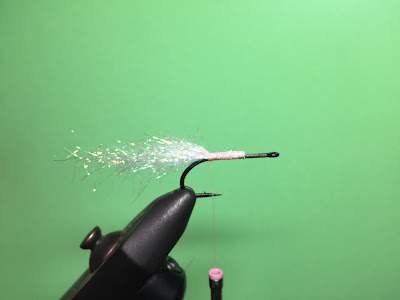It hadn't been too long since my friend Greg had released a couple of new materials and if you know Greg's material, it is always worth experimenting with. The two newer materials that ended up on my desk were Senyo's Laser Dub and Senyo's Shaggy Dub. I had been looking at the Shaggy Dub for some time knowing that there was a fly wanting to come out.
Below is the fly that came out of that brainstorming session and that went on to catch more fish on the flats than I could count. I hope you get the chance to tie some up and get em wet on a sand flat somewhere soon.
Materials:
Hook: Gamakatsu SL45 #2-#8
Thread: Danville 6/0 Flymaster Waxed - Shrimp Pink
Mono Shrimp Eyes
Weight: Various size bead chain and lead dumbbells
Senyo's Shaggy Dub - Tan
Senyo's Laser Dub - Pale Pink
Ice Dub - Pearl
Krystal Flash - Shrimp Pink
Craft Fur - Tan
Step 2: Take a pinch of pearl Ice Dub and form a small bundle twice the length of the hook. Tie it in even with the barb of the hook making sure that a length slightly longer than the hook is protruding off the end of the hook. Wrap down the remaining material about 2/3's of the way up the shank, then fold the left over material back and return to tie in point.
Step 3: Grab two mono shrimp eyes (easy to make by melting the end of heavy mono and then coloring with markers) and tie in so the eye protrude past the tie in point about one hook length. Tie one on each side of the shank making sure that they angle slightly downward. As you wrap the butt ends down toward the eye of the hook, bring the mono steadily to the top of the hook to ensure the eyes keep the downward angle. Once you reach where the Ice Dub stopped, trim the mono butts off and wrap back to the tie in point.
Step 5: Next grab a small clump of Senyo's Laser Dub and begin dubbing a body starting with the area of the dumbbell and moving forward. Taper it from the from the rear to the front and finish at the same point as other materials previously tied in.
Step 6: Take a small clump of Senyo's Shaggy Dub and pull it out to a small bundle about twice the length of the hook. Center tie the clump just in front of the dubbed body and then pull the material perpendicular to the hook and capture with figure eight wraps until locked down tight.
Step 7: Grab all of the Shaggy Dub and pull rearward without stretching it and cut all of it even with the end of the hook. This should leave you with a nice leggy looking clump.
Step 8: Next take your craft fur and cut off a small bundle that you can use as topping. Be sure not to build up too large of a head when tying this material in. Make sure to tie it in longer than the eyes. Once captured well, trim the butt ends and clean up. At this point you can tie in mono weed guards or opt not to. I personally always do knowing that I can always cut them off if not wanted later.
Final tie quartering away
Various sizes of Shagnasty Shrimp with various weights as well
*All materials used unless noted are from Hareline Dubbin Inc. and available at a fly shop near you. If you can't find what you need contact us, and we will point you in the right direction!
A nice Belizean Bonefish caught on a Shagnasty Shrimp
Get out there and find some nice sunny sand lit flats and give this fly a try! I guarantee you won't regret having done so! I'll be headed south in no time and you can guarantee a section of my fly box will be loaded with these!



































